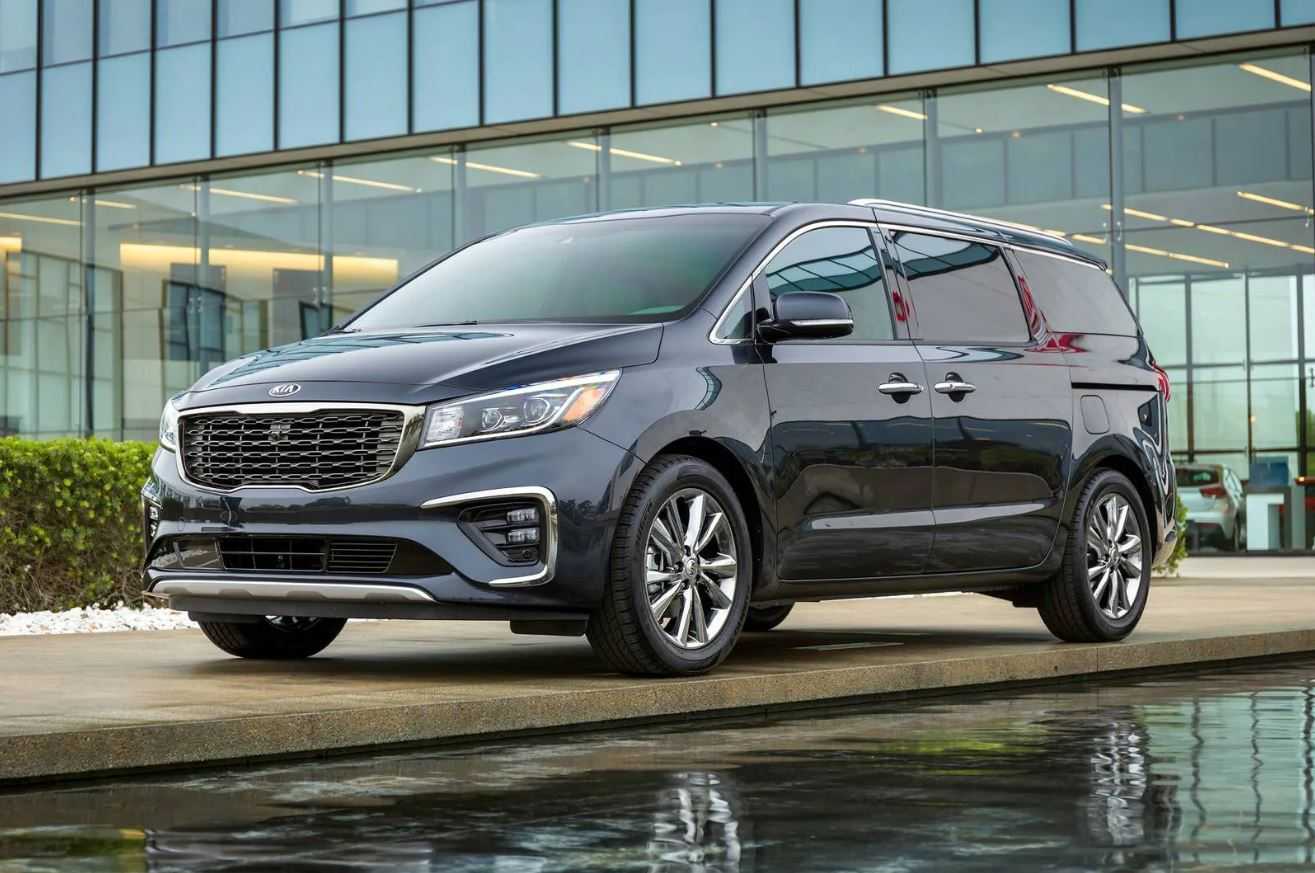Kia Sedona 2020 Trailer Towing User Manual
The Kia Sedona 2020’s towing capacity varies depending on the model and configuration. To determine your Kia Sedona’s specific towing capacity, consult the vehicle’s specifications and owner’s manual. When it comes to towing, the Kia Sedona 2020 has the features and technologies you need to have a safe and controlled towing experience.
It is critical to ensure that your vehicle is properly equipped and that your trailer is within the recommended weight limits before towing with the Kia Sedona 2020. Attaching the appropriate hitch, safety chains, and trailer lights to comply with local regulations and ensure a secure connection is part of this.
TRAILER TOWING
If you are considering towing with your vehicle, you should first check with your state’s Department of Motor Vehicles to determine the legal requirements.
Since laws vary the requirements for towing trailers, cars, or other types of vehicles or apparatus may differ. Ask an authorized Kia dealer for further details before towing.
WARNING
Towing a trailer
Always check your towing equipment to confirm correct equipment size and installation before use. Using incompatible or incorrectly installed trailer equipment can effect the vehicle operation and endanger you and your passengers.
You may require an additional wiring harness connector to install a trailer hitch. Please contact an authorized Kia dealer for more details.
WARNING
Weight limits
Before towing, make sure the total trailer weight, GCW (gross combination weight), GVW (gross vehicle weight), GAW (gross axle weight) and trailer tongue load are all within the limits.
CAUTION
Trailer installation
Follow instructions in this section when pulling a trailer. Pulling a trailer improperly can damage your vehicle and result in costly repairs not covered by your warranty.
Your vehicle can tow a trailer. To identify what the vehicle trailering capacity is for your vehicle, you should read the information in “Weight of the trailer” that appears later in this section.
Remember that trailering is different than just driving your vehicle by itself. Trailering means changes in handling, durability, and fuel economy. Successful, safe trailering requires correct equipment, and it has to be used properly.
This section contains important trailering tips and safety rules. Many of these are important for your safety and that of your passengers. Please read this section carefully before you pull a trailer.
Load-pulling components such as the engine, transmission, wheel assemblies, and tires are forced to work harder against the load of the added weight. The engine is required to operate at relatively higher speeds and under greater loads. This additional burden generates extra heat. The trailer also adds considerably to wind resistance, increasing the pulling requirements.
Hitches
It’s important to have the correct hitch equipment. Crosswinds, large trucks going by, and rough roads are a few reasons why you’ll need the right hitch. Here are some rules to follow:
- Will you have to make any holes in the body of your vehicle when you install a trailer hitch? If you do, then be sure to seal the holes later when you remove the hitch.
If you don’t seal them, deadly car-bon monoxide (CO) from your exhaust can get into your vehicle, as well as dirt and water.
The bumpers on your vehicle are not intended for hitches. Do not attach rental hitches or other bumper-type hitches to them. Use only a frame-mounted hitch that does not attach to the bumper.
Kia trailer hitch accessory is avail-able at an authorized Kia dealer.
Safety chains
You should always attach chains between your vehicle and your trailer. Cross the safety chains under the tongue of the trailer so that the tongue will not drop to the road if it becomes separated from the hitch.
Instructions about safety chains may be provided by the hitch manufacturer or by the trailer manufacturer. Follow the manufacturer’s recommendation for attaching safety chains. Always leave just enough slack so you can turn with your trailer. And, never allow safety chains to drag on the ground.
Trailer brakes
If your trailer is equipped with a braking system, make sure it conforms to your state’s regulations and that it is properly installed and operating correctly.
If your trailer weight exceeds the maximum allowed weight without trailer brakes, then the trailer will also require its own brakes as well. Be sure to read and follow the instructions for the trailer brakes so you’ll be able to install, adjust and maintain them properly.
- Don’t tap into or modify your vehicle’s brake system.
WARNING
Trailer brakes
Do not use a trailer with its own brakes unless you are absolute-ly certain that you have proper-ly set up the brake system. This is not a task for amateurs. Use an experienced, competent trailer shop for this work.
Driving with a trailer
Towing a trailer requires a certain amount of experience. Before setting out for the open road, you must get to know your trailer. Acquaint yourself with the feel of handling and braking with the added weight of the trailer. And always keep in mind that the vehicle you are driving is now a good deal longer and not nearly so responsive as your vehicle is by itself.
Before you start, check the trailer hitch and platform, safety chains, electrical connector(s), lights, tires and mirror adjustment. If the trailer has electric brakes, start your vehicle and trailer moving and then apply the trailer brake controller by hand to be sure the brakes are working. This lets you check your electrical connection at the same time.
During your trip, check occasionally to be sure that the load is secure, and that the lights and any trailer brakes are still working.
Following distance
Stay at least twice as far behind the vehicle ahead as you would when driving your vehicle without a trailer. This can help you avoid situations that require heavy braking and sudden turns.
Passing
You’ll need more passing distance up ahead when you’re towing a trailer. And, because of the increased vehicle length, you’ll need to go much farther beyond the passed vehicle before you can return to your lane. Due to the added load to the engine when going uphill the vehicle may also take longer to pass than it would on flat ground.
Backing up
Hold the bottom of the steering wheel with one hand. Then, to move the trailer to the left, just move your hand to the left. To move the trailer to the right, move your hand to the right. Always back up slowly and, if possible, have someone guide you.
Making turns
When you’re turning with a trailer, make wider turns than normal. Do this so your trailer won’t strike soft shoulders, curbs, road signs, trees, or other objects near the edge of the road. Avoid jerky or sudden maneuvers. Signal well in advance before turning or lane changes.
Turn signals when towing a trailer
When you tow a trailer, your vehicle has to have a different turn signal flasher and extra wiring. The green arrows on your instrument panel will flash whenever you signal a turn or lane change. Properly connected, the trailer lights will also flash to alert other drivers you’re about to turn, change lanes, or stop.
When towing a trailer, the green arrows on your instrument panel will flash for turns even if the bulbs on the trailer are burned out. Thus, you may think drivers behind you are seeing your signals when, in fact, they are not. It’s important to check occasion-ally to be sure the trailer bulbs are still working. You must also check the lights every time you disconnect and then reconnect the wires.
Do not connect a trailer lighting system directly to your vehicle’s lighting system. Use only an approved trailer wiring harness.
An authorized Kia dealer can assist you in installing the wiring harness.
CAUTION
Always use an approved trailer wiring harness. Failure to use an approved trailer wiring harness could result in damage to the vehicle electrical system.
Driving on grades
Reduce speed and shift to a lower gear before you start down a long or steep downgrade. If you don’t shift down, you might have to use your brakes so much that they would get hot and no longer operate efficiently.
On a long uphill grade, shift down and reduce your speed to around 45 mph (70 km/h) to reduce the possibility of engine and transmission overheating.
If your trailer weighs more than the maximum trailer weight without trail-er brakes and you have an automatic transmission, you should drive in D (Drive) when towing a trailer.
Operating your vehicle in D (Drive) when towing a trailer will minimize heat build up and extend the life of your transmission.
Towing up hill
- When towing a trailer on steep grades (in excess of 6%) pay close attention to the engine coolant temperature gauge to ensure the engine does not overheat.
If the needle of the coolant temperature gauge moves across the dial towards “H” (HOT), pull over and stop as soon as it is safe to do so, and allow the engine to idle until it cools down. You may proceed once the engine has cooled sufficiently.
You must decide driving speed depending on trailer weight and uphill grade to reduce the possibility of engine and transmission overheating.
Parking on hills
Generally, if you have a trailer attached to your vehicle, you should not park your vehicle on a hill. People can be seriously or fatally injured, and both your vehicle and the trailer can be damaged if they unexpected-ly roll downhill.
However, if you ever have to park your trailer on a hill, here’s how to do it:
- Pull the vehicle into the parking space. Turn the steering wheel in the direction of the curb (right if headed downhill, left if headed up hill).
- If the vehicle has an automatic transmission, place the vehicle in P (Park).
- Set the parking brake and shut off the engine.
- Place chocks under the trailer wheels on the down hill side of the wheels.
- Start the vehicle, hold the brakes, shift to neutral, release the parking brake and slowly release the brakes until the trailer chocks absorb the load.
- Reapply the brakes, reapply the parking brake and shift the vehicle to P (Park) for automatic transmission.
- Shut off the vehicle and release the vehicle brakes but leave the parking brake set.
When you are ready to leave after parking on a hill
- With the automatic transmission in P (Park), apply your brakes and hold the brake pedal down while you:
- Start your engine;
- Shift into gear; and
- Release the parking brake.
- Slowly remove your foot from the brake pedal.
Drive slowly until the trailer is clear of the chocks.
Stop and have someone pick up and store the chocks.
Maintenance when trailer towing
Your vehicle will need service more often when you regularly pull a trailer. Important items to pay particular attention to include engine oil, automatic transmission fluid, axle lubricant and cooling system fluid. Brake condition is another important item to frequently check. Each item is covered in this manual, and the Index will help you find them quickly. If you’re trailering, it’s a good idea to review these sections before you start your trip.
Don’t forget to also maintain your trailer and hitch. Follow the maintenance schedule that accompanied your trailer and check it periodically. Preferably, conduct the check at the start of each day’s driving. Most importantly, all hitch nuts and bolts should be tight.
CAUTION
Air conditioning
Do not use the A/C while using your vehicle to tow uphill. Due to higher load during trailer usage, overheating might occur on hot days or during uphill driving.
- When towing check transmission fluid more frequently.
If you do decide to pull a trailer
Here are some important points if you decide to pull a trailer:
- Consider using a sway control. You can ask a hitch dealer about sway control.
Do not do any towing with your vehicle during its first 1,200 miles (2,000 km) in order to allow the engine to properly break in. Failure to heed this caution may result in serious engine or transmission damage.
When towing a trailer, be sure to consult an authorized Kia dealer for further information on additional requirements such as a towing kit, etc. - Always drive your vehicle at a moderate speed (less than 60 mph (100 km/h)).
On a long uphill grade, do not exceed 45 mph (70 km/h) or the posted towing speed limit, whichever is lower. - The chart contains important considerations that have to do with weight:
| Engine Item |
Gasoline Engine | |
| Lambda II 3.3L GDI | ||
| Maximum trailer weight (lbs. (kg)) | Without brake system | 1,000 (453) |
| With brake system | 3,500 (1587) | |
| Maximum tongue weight (lbs. (kg)) | 350 (158) | |
To identify what the vehicle trailering capacity is for your vehicle, you should read the information in “Weight of the Trailer” that appears later in this section.
Weight of the trailer
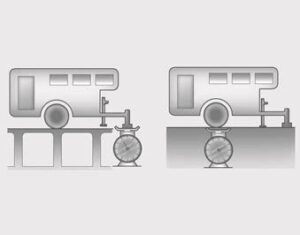
What is the maximum safe weight of a trailer It should never weigh more than the maximum trailer weight with trailer brakes. But even that can be too heavy.
It depends on how you plan to use your trailer. For example, speed, altitude, road grades, outside temperature and how often your vehicle is used to pull a trailer are all important. The ideal trailer weight can also depend on any special equipment that you have on your vehicle.
Weight of the trailer tongue
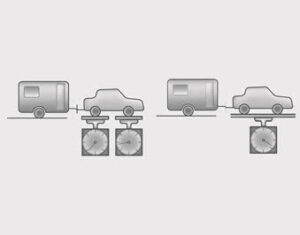
The tongue load of any trailer is an important weight to measure because it affects the total gross vehicle weight (GVW) of your vehicle. This weight includes the curb weight of the vehicle, any cargo you may carry in it, and the people who will be riding in the vehicle. And if you will tow a trailer, you must add the tongue load to the GVW because your vehicle will also be carrying that weight.
The trailer tongue should weigh a maximum of 10% of the total loaded trailer weight, within the limits of the maximum permissible trailer tongue load. After you’ve loaded your trailer, weigh the trailer and then the tongue, separately, to see if the weights are proper. If they aren’t, you may be able to correct them simply by moving some items around in the trailer.
WARNING
Trailer
Always follow the loading instructions provided with your trailer. Improper loading can effect vehicle operation and result in an accident.
VEHICLE LOAD LIMIT
Tire and loading information label
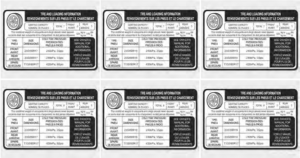
The label located on the driver’s door sill gives the original tire size, cold tire pressures recom-mended for your vehicle, the number of people that can be in your vehicle and vehicle capacity weight.
Vehicle capacity weight:
7 persons : 1,158 lbs. (525 kg)
8 persons : 1,323 lbs. (600 kg)
Vehicle capacity weight is the maxi-mum combined weight of occupants and cargo. If your vehicle is equipped with a trailer, the combined weight includes the tongue load.
Seating capacity:
Total – 7 persons
(Front seat : 2 persons,
Rear seat : 5 persons)
8 persons
(Front seat : 2 persons,
Rear seat : 6 persons)
Seating capacity is the maximum number of occupants including a driver, your vehicle may carry.
However, the seating capacity may be reduced based upon the weight of all of the occupants, and the weight of the cargo being carried or towed.
Do not overload the vehicle as there is a limit to the total weight, or load limit including occupants and cargo, the vehicle can carry.
Towing capacity:
Lambda II 3.3L GDI
Without trailer brakes
: 1,000 lbs (453 kg)
With trailer brakes
: 3,500 lbs (1,587 kg)
Towing capacity is the maximum trailer weight including its cargo weight, your vehicle can tow
Cargo capacity:
The cargo capacity of your vehicle will increase or decrease depending on the weight and the number of occupants and the tongue load, if your vehicle is equipped with a trail-er.
Steps for determining correct load limit
- Locate the statement “The combined weight of occupants and cargo should never exceed XXX kg or XXX lbs.” on your vehicle’s placard.
- Determine the combined weight of the driver and passengers that will be riding in your vehicle.
- Subtract the combined weight of the driver and passengers from XXX kg or XXX lbs.
- The resulting figure equals the available amount of cargo and lug-gage load capacity. For example, if the “XXX” amount equals 1,400 lbs. and there will be five 150 lb passengers in your vehicle, the amount of available cargo and lug-gage load capacity is 650 lbs.
(1,400-750 (5 x 150) = 650 lbs.) - Determine the combined weight of luggage and cargo being loaded on the vehicle. That weight may not safely exceed the available cargo and luggage load capacity calculated in Step4
- If your vehicle will be towing a trailer, load from your trailer will be transferred to your vehicle. Consult this manual to determine how this reduces the available cargo and luggage load capacity of your vehicle.
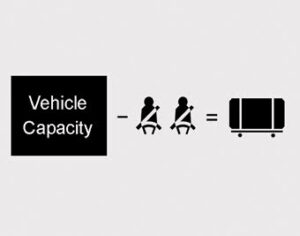
| Item | Description | Total |
| A | Vehicle Capacity Weight | 1,400 lbs (635 kg) |
| B | Subtract Occupant Weight 150 lbs (68 kg) × 2 | 300 lbs (136 kg) |
| C | Available Cargo and Luggage weight | 1,100 lbs (499 kg) |

| Item | Description | Total |
| A | Vehicle Capacity Weight | 1,400 lbs (635 kg) |
| B | Subtract Occupant Weight 150 lbs (68 kg) × 5 | 750 lbs (340 kg) |
| C | Available Cargo and Luggage weight | 650 lbs (295 kg) |
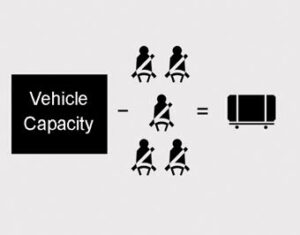
| Item | Description | Total |
| A | Vehicle Capacity Weight | 1,400 lbs
(635 kg) |
| B | Subtract Occupant Weight 172 lbs (78 kg) × 5 | 860 lbs
(390 kg) |
| C | Available Cargo and Luggage weight | 540 lbs
(245 kg) |
Refer to your vehicle’s tire and loading information label for specific information about your vehicle’s capacity weight and seating positions. The combined weight of the driver, passengers and cargo should never exceed your vehicle’s capacity weight.
Certification label
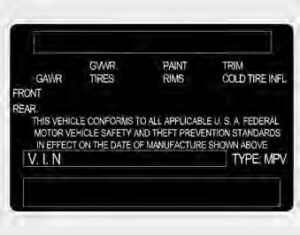
The certification label is located on the driver’s door sill at the center pillar.
This label shows the maximum allowable weight of the fully loaded vehicle. This is called the GVWR (Gross Vehicle Weight Rating). The GVWR includes the weight of the vehicle, all occupants, fuel and cargo.
This label also tells you the maxi-mum weight that can be supported by the front and rear axles, called Gross Axle Weight Rating (GAWR).
To find out the actual loads on your front and rear axles, you need to go to a weigh station and weigh your vehicle. Your dealer can help you with this. Be sure to spread out your load equally on both sides of the center-line.
WARNING
Over loading
Never exceed the GVWR for your vehicle, the GAWR for either the front or rear axle and vehicle capacity weight. Exceeding these ratings can affect your vehicle’s handling and braking ability.
The label will help you decide how much cargo and installed equipment your vehicle can carry.
WARNING
If you carry items inside your vehicle – like suitcases, tools, packages, or anything else -they are moving as fast as the vehicle. If you have to stop or turn quickly, or if there is a crash, the items will keep going and can cause an injury if they strike the driver or a passenger.
WARNING
Over loading
Do not overload your vehicle. Overloading your vehicle can cause heat buildup in your vehicle’s tires and possible tire failure, increased stopping distances and poor vehicle handling all of which may result in a crash.
NOTICE
Overloading your vehicle may cause damage. Repairs would not be cov-ered by your warranty. Do not over-load your vehicle.
WARNING
Loose cargo
Do not travel with unsecured blunt objects in the passenger compartment of your vehicle (e.g. suit cases or unsecured child seats). These items may strike occupant during a sud-den stop or crash.
VEHICLE WEIGHT GLOSSARY
This section will guide you in the proper loading of your vehicle and/or trailer, to keep your loaded vehicle weight within its design rating capa-bility, with or without a trailer. Properly loading your vehicle will provide maximum return of the vehicle design performance. Before loading your vehicle, familiarize yourself with the following terms for determining your vehicle’s weight ratings, with or without a trailer, from the vehicle’s specifications and the certification label:
Base curb weight
This is the weight of the vehicle including a full tank of fuel and all standard equipment. It does not include passengers, cargo, or option-al equipment.
Vehicle curb weight
This is the weight of your new vehicle when you picked it up from your deal-er plus any aftermarket equipment.
Cargo weight
This figure includes all weight added to the Base Curb Weight, including cargo and optional equipment.
GAW (Gross axle weight)
This is the total weight placed on each axle (front and rear) – including vehicle curb weight and all payload.
GAWR
(Gross axle weight rating)
This is the maximum allowable weight that can be carried by a single axle (front or rear). These numbers are shown on the certification label.
The total load on each axle must never exceed its GAWR.
GVW (Gross vehicle weight)
This is the Base Curb Weight plus actual Cargo Weight plus passengers.
GVWR
(Gross vehicle weight rating)
This is the maximum allowable weight of the fully loaded vehicle (including all options, equipment, passengers and cargo). The GVWR is shown on the certification label located on the driver’s door sill.
FAQs
The Kia Sedona 2020 can tow a maximum of 3,500 pounds when fully equipped
Within the limits of its maximum towing capability, the Kia Sedona 2020 is built to tow trailers.
A Class III trailer hitch is normally needed to tow the Kia Sedona 2020. For exact hitch specifications, it is advised to check the owner’s manual or a Kia store.
If the weight of the trailer does not exceed the Kia Sedona 2020’s maximum towing capability, it is possible to tow some campers or compact RVs.
A built-in trailer brake controller is not generally included with the Kia Sedona 2020. For trailers with electric brakes, it might feature provisions for mounting an aftermarket brake controller.
The Kia Sedona 2020 is capable of towing a boat, provided that the total weight of the boat and trailer does not go beyond the car’s maximum towing capacity.
The 2020 Kia Sedona might come with optional towing kits that come with extras like a wiring harness, trailer hitch, and perhaps a gearbox cooler for better towing performance.
The Kia Sedona 2020’s fuel economy may be impacted by towing a trailer. Increased fuel consumption may be a result of the trailer’s higher weight and wind resistance.
The 2020 Kia Sedona is normally only offered as a front-wheel drive (FWD) model. There is no all-wheel drive (AWD) mode for towing available.
The 2020 Kia Sedona might come equipped with safety technologies including Electronic Stability Control (ESC) and anti-lock brakes for better stability and control while towing, as well as Trailer Stability Assist (TSA), which aids in detecting and mitigating trailer wobble.
If the trailer weight exceeds a specified limit when towing with the Kia Sedona 2020, a weight distribution hitch may be advised. For further instructions, refer to the owner’s manual for your car.
Towing limits and limitations for the Kia Sedona 2020 should be found in the owner’s manual. These could include things like the maximum weight limit, the tongue weight of the trailer, and the right trailer loading.
To detect and reduce trailer sway and improve towing safety and stability, the 2020 Kia Sedona may come equipped with Trailer Stability Assist (TSA) or comparable systems.
To help with trailer maneuvering, the Kia Sedona 2020 may offer possibilities for attaching an aftermarket backup camera. For particular installation choices, it is advised to speak with a Kia dealership or approved repair facility.
Yes, you can often install extra towing equipment or accessories to the Kia Sedona 2020, such as weight distribution hitches, brake controllers, or towing mirrors. For compatible options and appropriate installation, seek advice from a Kia dealership or authorized service facility.
-
Useful Links
View Full User Guide: Kia Sedona User Manual | Auto User Guide
Download Manuals: Owner’s Manuals and Documents | Kia

